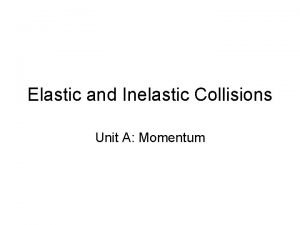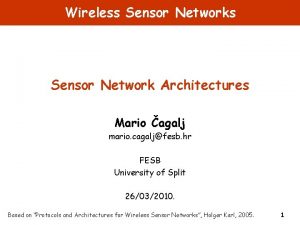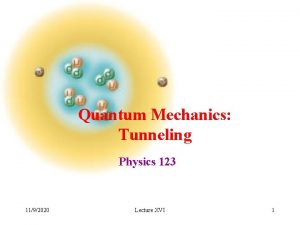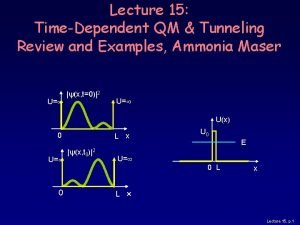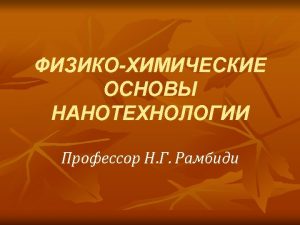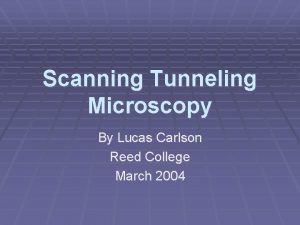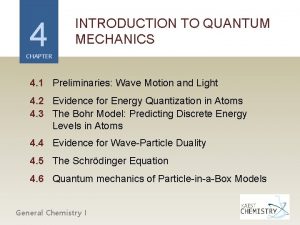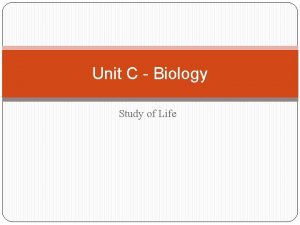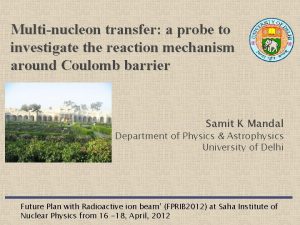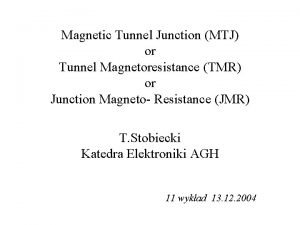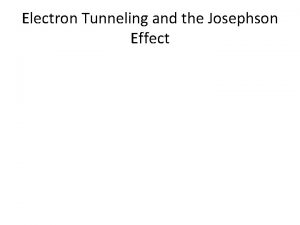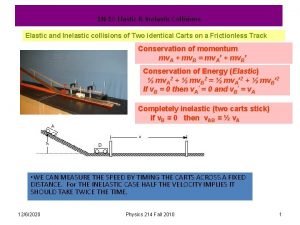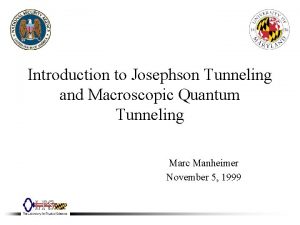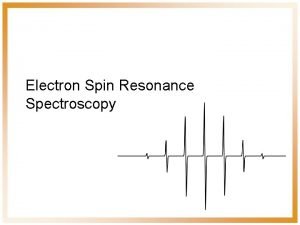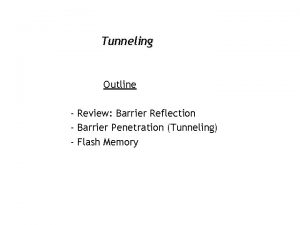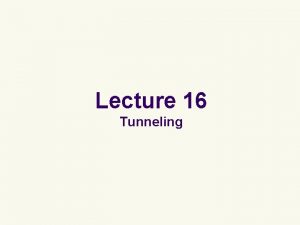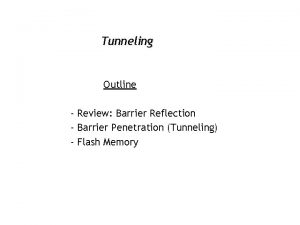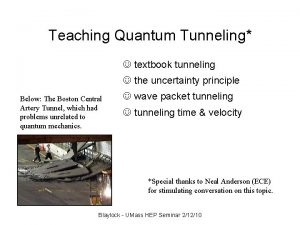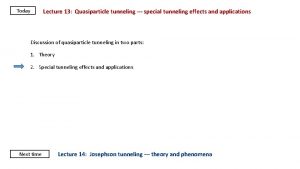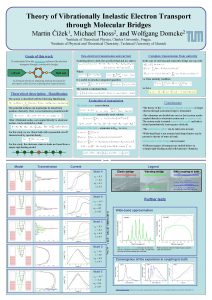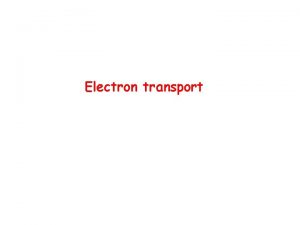Electron Transport and Inelastic Electron Tunneling Spectroscopy of

















- Slides: 17

Electron Transport and Inelastic Electron Tunneling Spectroscopy of Porphyrin in a Molecular Junction Teresa Esposito 1, Alexandra Krawciz 2, Peter H. Dinolfo 2, Kim Lewis 1 1 Department of Physics, Applied Physics, and Astronomy 2 Department of Chemistry and Chemical Biology Rensselaer Polytechnic Institute, Troy NY 12180

Porphyrin Motivation: – Circuit element for organic electronics Characteristics: – Highly conjugated aromatic molecule – Can be functionalized with a metal ion in the center – Functionalized with a protected thiol group (–SH) to form a covalent bond to gold Objective: – Zn- Porphyrin: use IETS – electrical or conductance switching 2 (Zn-Porphyrin)

Inelastic Electron Tunneling Spectroscopy (IETS) • Measure junction characteristics (I/V, d. I/d. V, and d 2 I/d. V 2) in order to investigate electron transport • Will give information on the vibrational modes of the molecule in the junction 3 http: //en. wikipedia. org/wiki/Inelastic_electron_tunneling_spectroscopy#mediaviewer/File: Second_derivative. gif

Elastic Electron Tunneling • Electrons tunnel from one electrode to the other without losing kinetic energy. Electrons do not interact with the molecule. e- e-e*Vbias eee- e- Energy Au Electrode 4 Molecule’s energy levels Position

Inelastic Electron Tunneling • Electrons donate energy (EV) to the molecule, exciting a vibrational mode and creating a new tunneling pathway. e- e-e*Vbias ee- e- Energy EV Position 5

Molecular Conductance • Modeled by the Landauer Formula • Where T(E) is the transmission function • Nanogaps without porphyrin can be modeled using Simmon’s equation 6

Nanowires • Fabricated using electron beam lithography at the Lurie Nanofabrication Facility at the University of Michigan in Ann Arbor • Au nanowires and contact pads on oxide layer grown on Si substrate • ~80 samples with two 30 nm x 100 nm wires 7

Electromigration • Electrons transfer momentum to nearby metal ions, causing displacement of the ions • Occurs in most metals when there is a high current density (~1012 A/m 2) at a defect • High reproducibility, consistently sized nanogap ~3 -8 nm in width e. Au+ Cathode Current 8 ee- nanowire Anode

Electromigration Point where electromigration occurs 9

SEM Images • Images from the Zeiss Supra 55 SEM Anode Cathode 10 ~6 nm gap

IV for an Empty Nanogap 11

Electronics to measure IETS SRS DS 360 Low distortion function generator NI USB 6259 DAQ board AC/DC Mixer Keithley 2100 Digital Multimeter (DC Voltage) Sample via breakout box to 4. 2 K cryostat SR 570 Low noise current preamplifier SR 830 Lock-in amplifier (d. I/d. V) 12 SR 830 Lock-in amplifier (d 2 I/d. V 2) Keithley 2100 Digital Multimeter (DC current)

Diode Test • In order to test the functionality of the IETS setup, testing was completed with a tunneling diode at 300 K • One peak due to Diodes having two “states” – No current for negative voltage – Increasing current for positive voltage 13

IR Spectroscopy of Porphyrin • Vibrational modes: • 750 – 1750 cm-1: porphyrin core & phenyl-ethynylphenyl (PEP) side groups • 2800 – 3000 cm-1: C-H modes IETS can identify vibration modes intrinsic to porphyrin structure beyond the metal-molecule vibration mode. 14 Calculations completed by Dr. Peter Dinolfo, Department of Chemistry, RPI.

Conclusion and Future Testing • IETS of empty nanogaps at 5 K – No peaks due to tunneling current • IETS of Zn. P-A 1 at 5 K – Look for evidence of switching • Comparison to theoretical calculations of vibrational modes- DFT calculation • Improve electromigration technique in order to thin wires enough such that fewer porphyrins bridge the nanogap • Compare IETS of different analogs of porphyrin 15

Acknowledgements • Dr. Lewis’ Hybrid Electronics & Characterization Lab – Dr. Kim Lewis, Dr. Guougang Qian, Qi Zhou, Andrew Horning, Samuel Ellman, Maria Del Pili Pujol Closa. • Dr. Dinolfo’s Chemistry Group – Dr. Peter H. Dinolfo, Dr. Alexandra Krawicz, Marissa Civic • Dr. Meunier’s Computational Physics group – Dr. Vincent Meunier, Dr. Jonathan Owens • Cleanroom support staff 16

References Qian, G. , Saha, S. , Lewis, K. M. Ap. Phys. Lett. 96, 24307 (2010). Qiu, X. H. , Nanzin, G. V. , Ho, W. Phys. Rev. Lett. 93(19), 196806 (2004). Saha, S. , Owens, J. R. , Meunier, V. , Lewis, K. M. Ap. Phys. Lett. 103, 173101 (2013). Saha, S. , Qian, G. , Lewis, K. M. J. Vac. Sci. Technol B 29(6), 061802 (2011). Simmons J. G. J. Ap. Phys. 34(6), 1793 (1963). Wang, W. , Lee, T. , Kretzschmar, I. , Reed, M. A. Nano. Lett. 4, 643 (2004). 17
 Elastic vs inelastic vs perfectly inelastic
Elastic vs inelastic vs perfectly inelastic Elastic vs inelastic collision
Elastic vs inelastic collision Wsn tunneling
Wsn tunneling Tunneling coefficient
Tunneling coefficient Qm tunneling
Qm tunneling Define scanning tunneling microscope
Define scanning tunneling microscope Tunneling in quick bread products
Tunneling in quick bread products Tunneling
Tunneling Scanning tunneling microscope history
Scanning tunneling microscope history Vpn tunneling
Vpn tunneling Iodine dns tunnel tutorial
Iodine dns tunnel tutorial Scanning tunneling microscope
Scanning tunneling microscope 1941-1882
1941-1882 Scanning tunneling microscope
Scanning tunneling microscope Tunneling effect
Tunneling effect Azure forced tunneling
Azure forced tunneling Exchange coupling
Exchange coupling Antiporters
Antiporters
